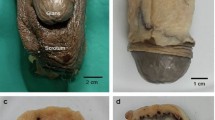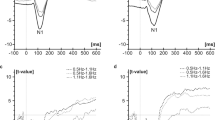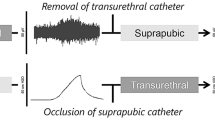Abstract
Neurophysiologic examinations in differential diagnosis of erectile dysfunction comprise electromyogramme of the pelvic floor, pudendal nerve terminal motor latency (PNTML) and evaluation of pudendal somatosensory evoked potentials (SSEP). We focused our interest on comparing diagnostic importance of penile and perianal pudendal nerve SSEP.
We examined 20 patients suffering from erectile dysfunction and 20 patients without any manifestation of impotence. The stimulus was administered using penile ring electrodes at the base of the penis (cathode) and distally on the penis shaft (anode), as well as a perianal surface electrode applied at 3 o'clock in lithotomy position and 5 cm laterally on the gluteal skin. The potentials were recorded with intradermal needle electrodes at Cz–2 cm (different) and Fz (indifferent). 500 stimuli were averaged for a single tracing. The stimulus strength was set at an average of 3–4 times the stimulus threshold.
Cortical latency of P 40 ranged from 39.0 to 45.6 ms (penile) and from 33.6 to 43.2 ms (perianal) in the control group, in the patient group latencies ranged from 38.8 to 51.6 (penile) and 34.0 to 44.8 ms (perianal). In two patients no potential was recordable after perianal stimulation, one patient showed a marked prolongation of the penile response with a normal perianal latency. Penile and perianal latencies of P 40 were significantly prolongued in the patient group compared to the control group (P<0.05).
The combination of penile and perianal pudendal SSEP may provide valuable additional information in differential diagnosis of erectile dysfunction, especially allowing to identify different sites of neurogenic lesions. In contrast to perianal pudendal SSEP, penile stimulation may help to discover pathologic changes in the distal course of the pudendal nerve, especially the dorsal nerve of the penis.
This is a preview of subscription content, access via your institution
Access options
Subscribe to this journal
Receive 8 print issues and online access
$259.00 per year
only $32.38 per issue
Buy this article
- Purchase on Springer Link
- Instant access to full article PDF
Prices may be subject to local taxes which are calculated during checkout
Similar content being viewed by others
References
Hugonnet C, Wisard M, Despland DA. . Evaluation neurophysiologique des dysfonctions érectiles. Helv Chir Acta 1993 60, 351–354.
Jost WH et al.Elektrophysiologische diagnostik der erektilen dysfunktion. Urologe A 1996 35, 120–126.
Klausner AP, Batra AK. . Pudendal nerve somatosensory evoked potentials in patients with voiding and/or erectile dysfunction: correlating test results with clinical findings. J Urol 1996 156, 1425–1427.
Moon JH, Kang SW, Chun SI. . Pudendal somatosensory evoked potential and bulbocavernosus reflex testing in erectile dysfunction. Yonsei Med J 1993 34, 71–77.
Montague DK. . Disorders of Male Sexual Function. Year Book: Chicago 1988.
Tackmann W, Porst H. . Der bulbocavernosusreflex bei kontrollen und patienten mit potenzstörungen. Z EEG‐EMG 1986 17, 147–152.
Dettmers C et al.Evaluation of erectile dysfunction with the sympathetic skin response in comparison to bulbocavernosus reflex and somatosensory evoked potentials of the pudendal nerve. Electromyogr Clin Neurophysiol 1994 34, 437–444.
Haldeman S, Bradley WE, Bhatia N. . Evoked responses from the pudendal nerve. J Urol 1982 128, 974.
Tackmann W, Porst H, van Ahlen H. . Bulbocavernosus reflex latencies and somatosensory evoked potentials after pudendal nerve stimulation in the diagnosis of impotence. J Neurol 1988 235, 219–225.
Jost WH. . Somatosensory evoked potentials of the pudendal nerve in penile hypoesthesia. J Urol 1998 159, 987.
Scheiber‐Nogueira MC. . Investigation neurologique et neurophysiologique du patient impuissant. Ann Urol Paris 1993 27, 131–135.
Vodušek DB, Ravnik‐Oblak M, Oblak C. . Pudendal versus limb nerve electrophysiological abnormalities in diabetics with erectile dysfunction. Int J Impot Res 1993 5, 37–42.
Loening‐Baucke V, Read NW, Yamada T, Barker AT. . Evaluation of the motor and sensory components of the pudendal nerve. Electroencephalogr Clin Neurophysiol 1994 93, 35–41.
Bemelmans BLH et al.Penile sensory disorders in erectile dysfunction: results of a comprehensive neuro‐urophysiological diagnostic evaluation in 123 patients. J Urol 1991 146, 777–782.
Author information
Authors and Affiliations
Rights and permissions
About this article
Cite this article
Kaiser, T., Jost, W., Osterhage, J. et al. Penile and perianal pudendal nerve somatosensory evoked potentials in the diagnosis of erectile dysfunction. Int J Impot Res 13, 89–92 (2001). https://doi.org/10.1038/sj.ijir.3900520
Received:
Accepted:
Published:
Issue Date:
DOI: https://doi.org/10.1038/sj.ijir.3900520
Keywords
This article is cited by
-
Sex differences in pudendal somatosensory evoked potentials
Techniques in Coloproctology (2014)



